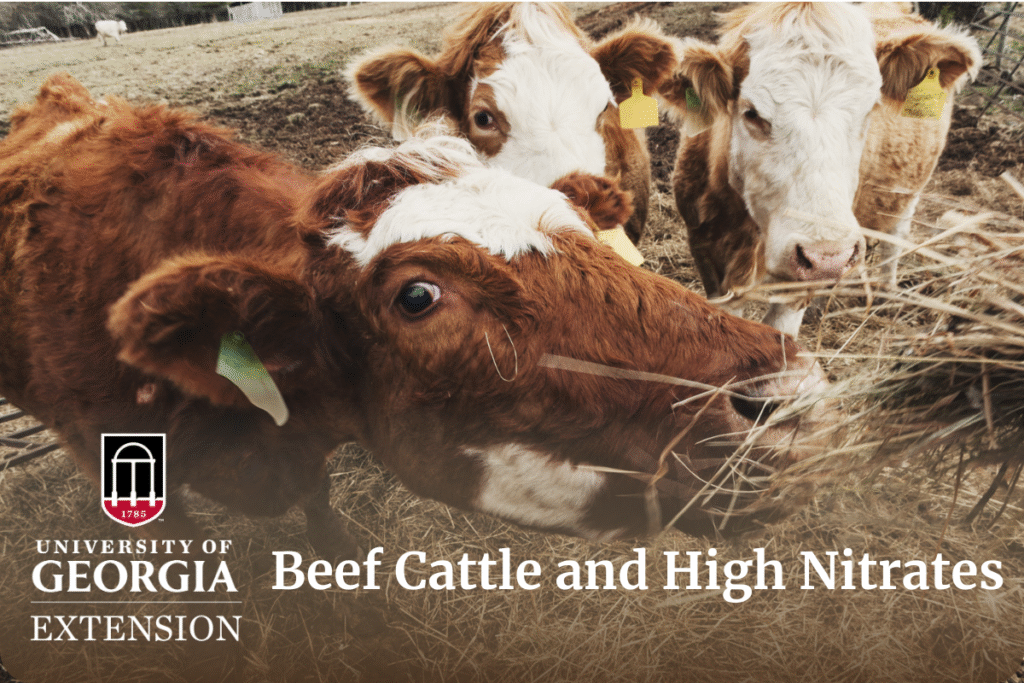
Nitrate accumulation in forages is a serious but often overlooked risk for beef cattle operations. While nitrates occur naturally in plants, drought, over-fertilization, or cloudy weather can cause levels to spike high enough to threaten cattle health. Understanding how nitrates build up—and how to manage them—can prevent costly losses.
How Nitrates Accumulate
Plants absorb nitrogen from the soil primarily as nitrate (NO₃⁻). Under normal growing conditions, plants convert nitrate into protein. Stress slows this conversion, allowing nitrate to accumulate in stems and leaves. Common stressors include:
- Drought or sudden frost that halts plant growth
- Excess nitrogen fertilization or heavy manure application
- Prolonged cloudy weather that reduces photosynthesis
Annual forages such as sorghum, sudangrass, pearl millet, small grains, and even some cool-season grasses are especially prone to high nitrate levels.
Risk to Cattle
When ruminants consume high-nitrate forage, rumen microbes convert nitrate to nitrite faster than they can reduce nitrite to ammonia. Nitrite is absorbed into the bloodstream where it binds to hemoglobin, forming methemoglobin and reducing the blood’s oxygen-carrying capacity.
Clinical signs of nitrate poisoning include:
- Rapid breathing, muscle tremors, and weakness
- Chocolate-brown blood and mucous membranes
- Abortion in pregnant cows
- Sudden death in severe cases
Symptoms can appear within hours of ingestion.
Testing and Thresholds
The only way to know nitrate levels is through laboratory testing. Collect a representative hay or forage sample and request a nitrate or nitrate-nitrogen analysis. Your county extension agent can assist with proper testing and help you interpret the results.
Typical interpretation guidelines form UGA Extension (dry matter basis):
- Under 4,500 ppm nitrate-N : Safe to feed with adequate feed and fresh water
- 4500 – 6500 ppm nitrate-N: Safe under most conditions but if feeding pregnant animals limit it to 1/2 the total ration
- 6500 – 9000 ppm nitrate-N: limit to 1/2 the total ration
- 9000 – 15000 ppm nitrate-N: limit to 1/3 of the total ration
Management Strategies
If hay tests high but not extreme, producers can often reduce risk by:
- Diluting and blending with low-nitrate hay or grain to keep total dietary nitrate low.
- Feeding smaller, more frequent meals to avoid a large nitrate load.
- Ensuring adequate energy intake, which helps rumen microbes convert nitrate safely.
- Avoiding sudden changes—gradually introduce suspect forage.
If blending hay isn’t an option, unroll the low-nitrate hay first and allow the herd to eat most of it before offering any high-nitrate bales. Make sure the animals are not overly hungry when they begin eating the higher-nitrate hay—slow, gradual intake is critical for reducing the risk of toxicity.
When nitrate levels are dangerously high, consider ensiling the forage. Proper fermentation can reduce nitrate concentrations by 30–50%, but testing after ensiling is still essential.
Prevention Tips
- Monitor nitrogen fertilizer rates and timing.
- Avoid grazing or harvesting drought-stressed or recently fertilized forage too soon after a rain.
- Sample and test any suspect hay before feeding, especially in drought years.
Bottom line: Nitrates in hay are invisible and odorless, but they pose a real risk to beef cattle health and profitability. Regular forage testing, cautious feeding strategies, and sound agronomic practices are the best insurance against nitrate poisoning.
https://secure.caes.uga.edu/extension/publications/files/pdf/C%20915_7.PDF